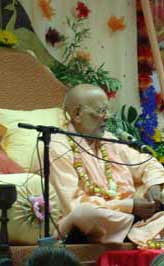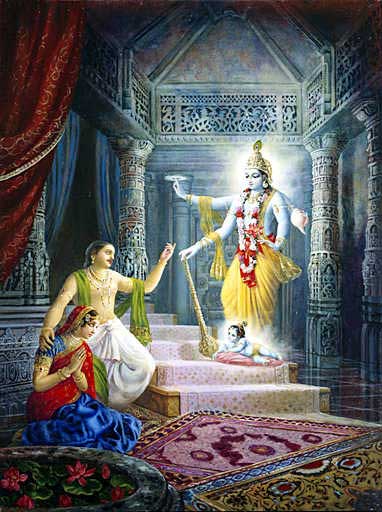Sri Srimad Bhaktivedanta Narayana Maharaja
July 9, 2007, part 2
Germany
For the benefit of those who do not know about spiritual life full with Vedic wisdom, Srila Vyasadeva wrote down what he saw in his trance. First he wrote the four essential verses (catuh-sloki) of Srimad-Bhagavatam. Lord Narayana had spoken it to Brahma, Brahma then spoke it to Narada, and then Narada elaborated upon it. Narada told it to Vyasa with elaboration, and instructed Vyasadeva, "You should elaborate upon it further. Vyasadeva then wrote Srimad-Bhagavatam.
Those who do not know the topics in Srimad-Bhagavatam are ignorant. What Vyasadeva saw in his trance, he wrote down for them:
anarthopasamam saksad
bhakti-yogam adhoksaje
lokasyajanato vidvams
cakre satvata-samhitam
["The material miseries of the living entity, which are superfluous to him, can be directly mitigated by the linking process of devotional service. But the mass of people do not know this, and therefore the learned Vyasadeva compiled this Vedic literature, which is in relation to the Supreme Truth. (Srimad-Bhagavatam, 1.7.6)]
Then he called his son, Srila Sukadeva Gosvami, and taught Srimad-Bhagavatam to him. Sukadeva Gosvami was detached from worldly things from birth.
Pariksit Maharaja was a very powerful King, who can check the influence of Kali (the Age of quarrel and hypocracy). Somehow he was cursed by a brahmana's son who declared: "After seven days you will be bitten by a very poisonous snake and die." Besides being a powerful king, Pariksit Maharaja was a very pious and religious person. A person like him could never insult a devotee, but He did so by the wish of Krsna, by the influence of Krsna's spiritual potency called Yogamaya.
Pariksit Maharaja was so fortunate that Krsna saved him when he was attacked by a dangerous weapon in the womb of his mother. Now, Krsna wanted that the Srimad-Bhagavatam should come through him. Krsna wanted that this glorious epic be on his head. Thus, to give him this glory, Yogamaya made him insult a brahmana.
The brahmana's son declared, "After seven days, a snake will come and bite you and you will die." When he heard about the curse, Pariksit Maharja at once gave up his entire kingdom and all possessions. Not drinking water, passing urine, bathing, or doing anything else, he went to the bank of the Ganges and sat there.
In the meantime, in order to see his glorious passing from this world, all the great sages and exalted saints came from all over the world, like Narada, Vyasa, Gautama, Vaisistha and others. There were no telephones in those days, 5,000 years ago, and no internet, but they knew about the curse and came at once.
Srila Sukadeva Gosvami also came, and everyone present honored him. He was a beautiful youth and quite naked. As he was on his way to see Maharaja Pariksit, some foolish ladies and boys surrounded him and followed him, thinking, "He is a mad person." They threw dust on his body, and village boys threw stones at his body. When he arrived, all those in the exalted assembly stood up and honored him, and the foolish boys fled.
Pariksit Maharaja asked Sukadeva Gosvami, "What is the aim and object of our lives? How can one be happy? Please tell me. What should one do if he just about to die? And, regarding those who are going to die tomorrow, in a year, after ten years, one hundred years, or two-hundred years - what should they do?"
These were Maharaja Pariksit's two main questions, and he asked many other questions as well. What Pariksit Maharaja asked and what Srila Sukadeva Gosvami answered is called Srimad-Bhagavatam.
Why did Krsna appear in this world? There is not only one reason, but so many reasons.
One reason is as follows: So many kings in Treta-yuga like Ravana and his associates were killed in battle. All the demons later became very powerful ksatriya kings and were engaged in so many nefarious activities that burdened the Earth.
Brahma became very worried. He went with Prthvi (the personified Earth planet in the form of a cow), Sankara (Lord Siva) and the other demigods to the Ocean of Milk. There he began to meditate on Sri Krsna's incarnation as Lord Garbhodakasayi Visnu. In his trance he heard the Lord's reply to his prayers:
"I already know about this. My Master, the Supreme Personality of Godhead, Krsna, is also aware, and He will quickly descend. All the demigoddesses should come in the form of Earthly ladies to Gokula, Vrndavana, and Mathura. All you demigods should also come, in the form of cowherd-men and members of the Yadu dynasty. Those appearing in Gokula will serve Sri Krsna and Srimati Radhika. Krsna will appear very soon."
Then, all the demigods and Brahma returned to their abodes. So, to fulfill the desire of the demigods and to relieve the burden of the Earth, Krsna appeared.
This is one reason for Krsna's descent.
yada yada hi dharmasya
glanir bhavati bharata
abhyutthanam adharmasya
tadatmanam srjamy aham
["Whenever and wherever there is a decline in religious practice, O descendant of Bharata, and a predominant rise of irreligionat that time I descend Myself." (Bhagavad-gita, 4.7)]
paritranaya sadhunam
vinasaya ca duskrtam
dharma-samsthapanarthaya
sambhavami yuge yuge
["To deliver the pious and to annihilate the miscreants, as well as to reestablish the principles of religion, I Myself appear, millennium after millennium. (Bhagavad-gita, 4.8)]
Another reason:
Narada Muni was another cause for Krsna's descent. Once during Narada's travels, he saw the two sons of Kuvera, Nalakuvera and Manigriva, playing with many heavenly apsara girls in the Mandakini Ganges. The sons of Kuvera and all the girls were naked like trees and stones, drinking wine and totally shameless. When the girls saw Narada coming on that path, they became ashamed. They folded their hands, covered themselves with garments, and prayed to Narada from far away.
The two men, on the other hand, completely mad and intoxicated by wine, began abusing both the girls and Narada. They called out, "Why has this man come here and disturbed everything? Why did he come by this side? There are so many other ways he could have gone."
Nalakuvara and Manigriva were sons of the treasurer of the demigods, Kuvera, who was a great devotee of Lord Siva. By the grace of Lord Siva, Kuvera's material opulence had no limit.
Narada was very merciful. He thought, "They are sons of my friend Kuvera." Kuvera was Narada's friend, and Sankara was also his friend. Narada had been on his way to meet Kuvera, and when he saw that Kuvera's sons had become so degraded he thought, "I should punish them." He therefore cursed them: "You should become trees. You are behaving like trees, and so you should be trees."
At once they felt: "Oh, we are becoming trees!" They fell at Narada's lotus feet and prayed, "Oh master, we have made an offense. Please excuse us. Narada told them, "What I have foretold will not prove false; it will come true. But you will become trees in Gokula, where in Dvarapa-yuga Krsna will take birth and perform so many sweet pastimes. He will touch you, and you will be liberated. Not only that; you will attain bhakti and become His transcendental associates forever." So Krsna also descended to fulfill Narada's foretelling.
Another reason: There is a verse in Srimad-Bhagavatam which states,
satyam vidhatum nija-bhrtya-bhasitam
vyaptim ca bhutesv akhilesu catmanah
adrsyatatyadbhuta-rupam udvahan
stambhe sabhayam na mrgam na manusam
["To prove that the statement of His servant Prahlada Maharaja was substantial - in other words, to prove that the Supreme Lord is present everywhere, even within the pillar of an assembly hall - the Supreme Personality of Godhead, Hari, exhibited a wonderful form never before seen. The form was neither that of a man nor of a lion. Thus the Lord appeared in His wonderful form in the assembly hall."]
Similarly, to prove true the words of the four Kumaras (Sanat, Sanaka, Sanatana and Sanandana Kumara), who had cursed Jaya and Vijaya to takes three births as demons on Earth, Sri Krsna descended here. Jaya and Vijaya became Hiranyaksa and Hiranyakasipu, then Ravana and Kumbakarana and then (at the time of Krsna Himself) Sisupala and Dantavakra. Krsna had to come to personally liberate Sisupala and Dantavakra, to prove true the words of the four sages.
Another reason is, Putana was the daughter of Bali Maharaja named Ratnamala in her previous birth. When Bali Maharaja's daughter saw Vamanadeva come in their assembly, seeing His beauty she thought, "It would be very good if He would become my son." However, when she saw Him as Trivikrama, who took the entire kingdom and even Bali Maharaja himself, and bound Bali in a snake-rope, she thought, "If He would be my son, I would give Him poison."
Ratnamala became Putana, who, in the disguise of a mother, was planning to kill Krsna by giving him poison. Krsna thought, "You have come as a mother," so He gave her that position. (After He killed her by sucking out the poison from her breast along with her life-airs, He gave her the position of a nurse in His abode, Goloka.)
Next, Devaki had six sons before begetting Krsna and Baladeva. Krsna came for them also, and this is a big history.
Krsna descended to perform sweet and opulent pastimes so that all would hear them and become forever liberated and easily attain Krsna-prema.
In addition, Krsna came to fulfill the promises He had made in the form of Ramacandra. Rama had gone to Dandakaranya forest with Sita and Laksmana to carry out the orders of His father. There He dressed as a sadhu. At that time, sixty-thousand sages were had been performing austerities and chanting gopala-mantra, that is, gopi-jana-vallabhaya svaha, for thousands of years. When they saw Rama and He glanced upon them, they had some inspiration, and they began to pray to Him, "Please fulfill our desires."
Rama knew that they wanted to serve Radha-Krsna conjugal and that they wanted to participate in rasa dance and other such pastimes. He therefore kindly and mercifully told them, "In My next birth I will be Krsna, and there in Vraja, by the help of Yogamaya, you will take birth from the wombs of gopis. At that time you can meet Me and I will fulfill your desires."
By Lord Ramacandra's mercy, they became the gopis who performed Katyayani-vrata in Vrndavana to attain Krsna as their husband. He came for them.
Another reason for Krsna's descent is as follows: When Rama went to Janaka Puri, the princesses there became charmed to see Him. When they saw that Sita married Him, they developed a very strong desire: "Oh, if Rama would also marry us, it would be so good. We want Rama to become our husband, and we will not marry anyone else." With this determination, they never married. Rama was pleased and told them, "You will take birth in Dvarapa-yuga in the wombs of gopis. In Krsna-lila, you will be gopis and I will marry you."
Another reason: In His later years, Ramacandra ordered Sita to leave His palace. She thus left and lived alone in Valmiki's asrama, where She gave birth to Rama's two sons. Rama was in His palace and Sita was in the forest. For certain reasons the king had left His queen, but Rama never left His dear Sita. [In other words, as an exemplary king who taught adherence to the strict rules and regulations of Varnasrama, Rama externally abandoned Sita because She was wrongly accused by some citizens of being unchaste. In His role of king, he was obliged to follow social and political etiquette. Internally, however, in His heart, He never abandoned Her. -ed.] He remained in His palace, but He was always remembering Her. He was not passing His days well. Feeling great separation, Rama would sometimes speak to His guru and priest, Vasistha Muni.
Once He requested him, "I want to perform a fire sacrifice, an asvamedha-yajna or any other yajna. Please allow Me to do this."
Vasistha replied, "Because You have left Your wife, You cannot perform any sacrifice. If You bring Her back and sit beside Her, then You can do it."
"That cannot be," Rama told him. "Please make any other arrangement so that I can perform the sacrifice."
Your father married 360 wives, so You can also marry again. I think that there are so many beautiful ladies in the world who would want to marry You. They will very easily be ready to marry You," Vasistha suggested.
Rama said, "No, I cannot marry anyone else."
"Then You cannot perform the sacrifice."
"Please somehow arrange it," Rama insisted.
Then Vasistha said, "You can make a golden statue of Sita. You can sit with that Sita and perform the sacrifice."
Every following year, Rama had one murti of Sita made, and these Deities were established by mantra. Vasistha Muni performed the prana-pratistha (installation ceremony) and he requested Lord Rama to chant mantras after him. Thus, these installed Deities were actually alive.
In Rama's last days, just before His pastimes in this world were completed and He was about to go to Ayodhya, His spiritual abode, all those Deities came and told Him, "We all want to go with You and always be with You." Rama replied, "In this incarnation I can only accept one Sita. Only one Sita will remain with Me. You are now so many. Go to Vrndavana and take birth from the wombs of gopis. I will manage everything there. I will fulfill all your desires." So Krsna also came for this reason as well.
Another reason:
sri-rajovaca
nandah kim akarod brahman
sreya evam mahodayam
yasoda ca maha-bhaga
papau yasyah stanam harih
["Having heard of the great fortune of mother Yasoda, Pariksit Maharaja inquired from Sukadeva Gosvami: O learned brahmana, Mother Yasoda's breast milk was sucked by the Supreme Personality of Godhead. What past auspicious activities did she and Nanda Maharaja perform to achieve such perfection in ecstatic love? (Srimad-Bhagavatam, 10.8.46)]
Krsna came to show the glory of Vrajavasis like Mother Yasoda to the world. In Krsna's incarnation of Lord Rama, no one could bind Him. Mother Kausalya could not bind Rama. His father died in separation for Him, but Nanda was so glorious that he did not die, because he knew that Krsna would find out and be sad. Moreover, although Krsna was the Supreme Lord and very powerful, still, Mother Yasoda was able to bind Him.
Another reason: Krsna came to establish the glory of Radhika and the gopis as greater than that of the queens of Dvaraka. He desired that no one should think the queens of Dvaraka to be superior.
Members of the Sri-sampradaya were quarreling with our Gaudiya-sampradaya in Galta-gaddi in Jaipur. They were saying, "Rukmini (Sri Krsna's wife in Dvaraka) can be situated on the side of Krsna, but not Radhika." Srila Baladeva Vidyubusana went there and defeated all their arguments. They asked him, "Do you have a commentary of Brahma-sutra?" He said, "We consider Srimad-Bhagavatam to be the commentary of Brahma-sutra." They replied, "We want to see a commentary specific to your sampradaya." That night, the Supreme Lord Govinda told him, I will speak, and whatever I speak, you should write." In this way, in one night, Srila Baladeva Vidya-bhusana wrote a commentary, based on the dictation of Lord Govinda, and this commentary became known as Govinda-bhasya.*[See endnote 1]
So Krsna came to establish this also.
na paraye 'ham niravadya-samyujam
sva-sadhu-krtyam vibudhayusapi vah
ya mabhajan durjara-geha-srnkhalah
samvrscya tad vah pratiyatu sadhuna
["I am not able to repay My debt for your spotless service, even within a lifetime of Brahma. Your connection with Me is beyond reproach. You have worshiped Me, cutting off all domestic ties, which are difficult to break. Therefore please let your own glorious deeds be your compensation." (Srimad-Bhagavatam, 10.32.22)]
To establish in the world the glory of the gopis, Krsna told them, "I am not able to repay you, even if I would attempt to do so for thousands of births. So please be satisfied by your own good qualities."
Krsna also came to establish that among all the gopis, including Candravali, Lalita, Visakha, Syamala and so many others, Srimati Radika is most superior. Srimad-Bhagavatam states:
anayaradhito nunam
bhagavan harir isvarah
yan no vihaya govindah
prito yam anayad rahah
["Certainly this particular gopi has perfectly worshiped the all-powerful Personality of Godhead, since Govinda was so pleased with Her that He abandoned the rest of us and brought Her to a secluded place. (Srimad-Bhagavatam, 10.30.28)]
anugrahaya bhaktanam
manusam deham asritah
bhajate tadrsih krida
yah srutva tat-paro bhavet
["Krsna manifests His eternal humanlike form and performs His pastimes to show mercy to the devotees. Having heard such pastimes, one should engage in service to Him." (Sri Caitanya-caritamrta Adi-lila 4.34)]
Sri Krsna was thinking, "If I bring My sweet pastimes from Goloka Vrndavana to this world, so many will see them and so many will hear their narrations." Those who are opposed to Krsna would be turned into devotees and those who are premi-bhaktas would go to Goloka Vrndavana. So Krsna came to fulfill the desires of different categories of devotees.
If anyone hears and always remembers these pastimes, that person will very soon attain Krsna-prema.
vikriditam vraja-vadhubhir idam ca visnoh
sraddhanvito 'nusrnuyad atha varnayed yah
bhaktim param bhagavati pratilabhya kamam
hrd-rogam asv apahinoty acirena dhirah
["Anyone who faithfully hears or describes the Lord's playful affairs with the young gopis of Vrndavana will attain the Lord's pure devotional service. Thus he will quickly become sober and conquer lust, the disease of the heart. (Srimad-Bhagavatam, 10.33.39)]
Those who hear with faith Krsna's sweet pastimes, especially rasa-lila, will attain kamanuga-bhakti (bhakti following in the wake of the beloved residents of Vrndavana), and at that time material lust and other bad qualities will go away. Those who have strong belief that first bhakti will come and then lust will go are called dhira, sober. On the other hand, those who think that first lust should go away and then they should hear about Krsna from authoritative sources are not dhira. They are offensive by this thinking.
So, Krsna came for so many reasons.
[*Endnote - "Sri Baladeva Vidyabhusana was born in a village near the famous Remuna in Orissa. He studied grammar, alankara (rhetoric) and nyaya sastra (logic) in an academic village on the bank of Cilka Hrada.
"After this, he went to Mysore to study the Vedas. In Udupi, he deeply studied Madhva-bhasya along with Sankara-bhasya, Parijata-bhasya and other bhasyas (commentaries) of the Vedanta. After some time, he studied the Ñat-sandarbhas under Sri Radha Damodara, a disciple of Sri Rasikananda Prabhu. At this time, he came to know of Sri Radha-Damodara's profound scholarship and devout life and became his disciple.
"Later on, in Vrindavana, he studied Srimad-Bhagavatam and the books of the Gosvamis from the famous Gaudiya rasikacarya Sri Visvanatha Cakravarti Thakura and, on his instruction, went to Jaipura.
"At the well-known Galta in Jaipura, he defeated the scholars of the Sri-sampradaya and other opponents to the Gaudiya line, and established the vigraha of Sri Vijaya Gopala. To increase the faith of the local scholars, he composed his Sri Govinda-bhasya on Brahma-sutra there, and reinstalled Sri Radha beside Sri Govindadeva in the famous Govinda Mandira.
"Govinda-bhasya, Siddhanta-ratnam, Vedanta-syamantaka, Prameya-ratnavali and Siddhanta-darpana and a commentary on Ñat-sandarbha, are some of the books he composed, which have enlarged the treasure-house of the Sri Gaudiya-Vaisnava literature." (Vraja Mandala Parikrama by Srila Bhaktivedanta Narayana Gosvami Maharaja)]

Transcriber and typist: Vasanti dasi
Editor: Syamarani dasi









